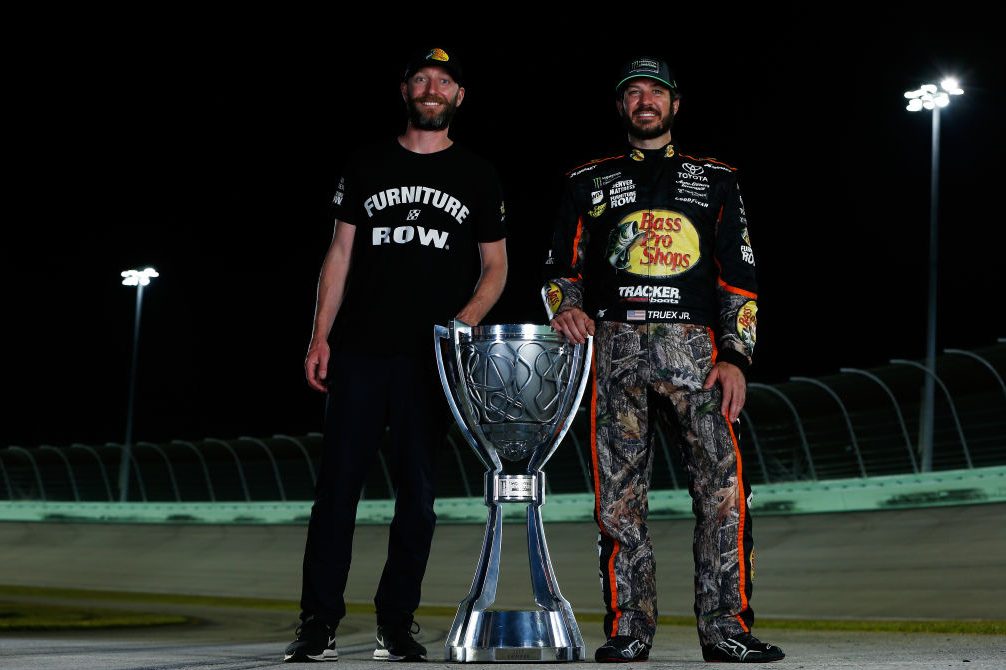
Imago
Cole Pearn (left) and Martin Truex (right) with the 2107 Bill France Cup

Imago
Cole Pearn (left) and Martin Truex (right) with the 2107 Bill France Cup
“It’s just overwhelming to think about all the rough days and bad days. I never thought this day would come, and to be here is so unbelievable.” Those are the words of Martin Truex Jr. after clinching his first NASCAR Cup Series title in 2017, capping a standout year with eight victories and a career-high 2,253 laps led. But much of the credit went to his crew chief, Cole Pearn, whose smart setups kept the No. 78 Furniture Row Racing Toyota ahead of the pack. It wasn’t just driver skill; it stemmed from close work with Toyota engineers.
Watch What’s Trending Now!
Toyota powered through 2017 with 16 total wins, including seven in the 10 playoff races, showcasing an edge that left rivals scrambling. Pearn’s role in that success has long sparked curiosity among fans about the behind-the-scenes tweaks that made the difference. Now, years later, Pearn has shared a key detail from that championship run.
The mastermind behind Martin Truex Jr.’s 2017 dominance recently spilled a secret from that title-winning season on social media. Responding to a fan’s theory about why the No. 78 car sparked and then surged ahead mid-race, Pearn simply stated, “Ti skirt.” This refers to using titanium side skirts instead of the traditional steel ones, a move that gave the team a subtle but effective advantage.
ADVERTISEMENT
I’m a diehard Truex Jr fan.
In 2017 anytime I saw him dragging the side skirts firing off in a race I was pumped because I knew within like 18-23 laps he was going to be lights-out fast.
I’ve got theories but I always wondered exactly what @colepearn was up to. pic.twitter.com/afGxgrg58Z
ADVERTISEMENT
— OffThePace (@OffThePace00) October 9, 2025
Titanium’s high strength-to-weight ratio, about 45% lighter than steel, allowed for better weight distribution without sacrificing durability, as noted in general NASCAR applications, where the material cuts overall car weight and improves handling. In 2017’s Gen-6 car era, before the 2022 Next Gen shift to composites, steel skirts could deform under stress, adding drag or uneven aero, but titanium resisted wear better, letting the team push limits on tracks where scraping was common.
ADVERTISEMENT
That innovation fit into broader scrutiny of side skirts, which had been controversial since at least 2014, when teams flared them for extra downforce, prompting NASCAR to monitor closely. By 2018, the series mandated composite materials to curb such tweaks, ensuring skirts held shape.
Pearn’s titanium choice, legal at the time, highlighted Toyota’s engineering push, as Brad Keselowski observed in 2017: “When that car rolled out at Daytona, and I think we all got to see it for the first time, I think there were two reactions: One, we couldn’t believe NASCAR approved it; and two, we were impressed by the design team over there. I don’t think anyone ever had a shot this year the second that thing got put on the racetrack and approved.”
Keselowski’s words, from post-Daytona comments, underscored how Toyota’s overall package overwhelmed the field, with Furniture Row’s independent setup amplified by Pearn’s creative parts like the titanium skirts, leading to Truex’s playoff prowess and ultimate crown.
ADVERTISEMENT
Pearn’s revelation didn’t just stir memories; it sparked lively chatter among fans online. Here’s how the NASCAR community reacted, blending awe, curiosity, and a touch of humor.
Fans react to Pearn’s old trick
One fan pondered the bigger picture behind Furniture Row Racing’s fate, saying, “I wonder why FRR couldn’t afford to keep racing…” This hits on the team’s 2018 shutdown after losing key sponsor 5-hour Energy, despite the 2017 title. A new thread emerged on this, where Joe Gibbs’ past got dragged into it.
ADVERTISEMENT
“Imagine a roundtable with Ray Evernham, Chad Knaus, Cole Pearn, Dale Inman & Robert Yates. Also, they can play Ouija Board to conjure up Smokey Yunick.” This nods to iconic crew chiefs like Evernham, who won three titles with Jeff Gordon in the 1990s, and Knaus, Hendrick’s strategist behind Jimmie Johnson’s seven championships from 2006 to 2016.
Inman and Yates built the Petty and Earnhardt eras, while Yunick’s 1950s-70s innovations, like hidden fuel lines, became lore. Pearn’s inclusion highlights his 2017 feats, where such a gathering could unpack decades of tricks.
Echoing that spirit of ingenuity, “The titanium side skirts would be lighter than steel, but I can’t imagine that was the benefit. Based on the comment Cole replied to I’m thinking titanium has a greater wear resistance than steel, so they could drag them on the ground and they’d last longer. Or maybe flex instead of wear off.”
Spot on, titanium’s density of 4.5 g/cm³ versus steel’s 7.8 g/cm³ shaves pounds, but its real edge in skirts is resisting abrasion during ground contact, maintaining aero integrity longer than steel, which bends or grinds down, as seen in pre-2018 inspections.
“Imagine all of the tricks Knaus could reveal if he retired. Would love to know all the shenanigans crew chiefs have done over the last decade.” Knaus, now Hendrick’s VP of competition since 2019, famously pushed boundaries, like the 2006 “T-Rex” car at All-Star that dominated but got banned for illegal mods. His 2010s tweaks, including laser-tuned setups, mirror Pearn’s era, where crew chiefs exploited gray areas in rules for edges.
Wrapping up with levity, one fan quipped, “Now I’m not explicitly calling you a cheater, Dale Jr.” This playful jab references Dale Earnhardt Jr.‘s 2014 Twitter storm, accusing rivals of skirt flaring, which cost his road manager a job. It ties back to how innovations like Pearn’s walk the line between smart and sneaky, keeping fans engaged.
ADVERTISEMENT
ADVERTISEMENT
ADVERTISEMENT

